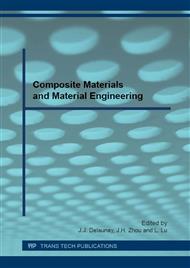[1]
J. Torrent-Burgues, E. Guaus, F. Sanz, Initial stages of tin electrodeposition from sulfate baths in the presence of gluconate, J. Appl. Electrochem., 32(2002) 225–230.
DOI: 10.4152/pea.200103247
Google Scholar
[2]
Sudibyoand N. Aziz, Semi-empirical Equation of Limiting Current for CobaltElectrodeposition in the Presence of Magnetic Field andAdditive Electrolyte, AIP Conf. Proc. 1711(2015) 020003-1–020003-6.
Google Scholar
[3]
J.T. Matsushima, F. Trivinho-Strixino, E. C. Pereira, Investigation of cobalt deposition using the electrochemical quartz crystal microbalance, Electrochim. Acta, 51(2006) 1960–(1966).
DOI: 10.1016/j.electacta.2005.07.003
Google Scholar
[4]
G. J. Acklandand E. S. Tweedie, Microscopic model of diffusion-limited aggregation and electrodeposition in the presence of levelling molecules, School of Physics, The University of Edinburgh, Scotland, United Kingdom, (2007).
Google Scholar
[5]
Sudibyo, N. Aziz, Development of semi empirical equation of limiting current for Lead (Pb) Magneto electrodeposition, Procedia Chemistry 16 ( 2015 ) 1 – 7.
DOI: 10.1016/j.proche.2015.12.001
Google Scholar
[6]
J. C. Mansur Filho, A. G. Silva, A. T. G. Carvalho, M. L. Martins, Electrocrystallization under magnetic fields: experiment and model, Physica A, 350(2005) 393–406.
DOI: 10.1016/j.physa.2004.11.009
Google Scholar
[7]
S. P. Nikolai, M. S. Polina, M. Inoue, Investigations of the magnetic field effect on electrochemical processes. J. Magn. Mag. Mat., 272(2004) 2448-2449.
Google Scholar
[8]
J.L. Rosa, A. Robin, M.B. Silva, C.A. Baldan and M.P. Peres, Electrodeposition of copper on titanium wires: Taguchi experimental design approach. J. Proc. Tec. 209( 2009) 1181-1188.
DOI: 10.1016/j.jmatprotec.2008.03.021
Google Scholar
[9]
Z. Nor Ain, A. Syamsul Rizal, and A. Khairunisak Abdul, Applying the Taguchi Method to Optimise the Size of Silica Nanoparticles Entrapped with Rifampicin for a Drug Delivery System. J. Engineering Science, 11(2015) 9–16.
Google Scholar
[10]
M. Biehl, Modelling and simulation. Institute of Mathematics and Computing Science. The Netherlands, (2005).
Google Scholar
[11]
I. Mogi, M. Kamiko, Striking effects of magnetic field on the growth morphology of electrochemical deposits. J. Cryst. Growth, 166(1996) 276-280.
DOI: 10.1016/0022-0248(95)00537-4
Google Scholar
[12]
I. Mogi, M. Kamiko, S. Okubo, Magnetic field effects on fractal morphology in electrochemical deposition. Physica B, 211(1995) 319-322.
DOI: 10.1016/0921-4526(94)01055-6
Google Scholar
[13]
G. Hinds, F. E. Spada, J. M. . DCoey, T. R. Ni Mhiocha´in, M. E. G. Lyons, Magnetic field effects on copper Electrolysis.J. Phys. Chem. B, 105(2001) 9847-9502.
Google Scholar


